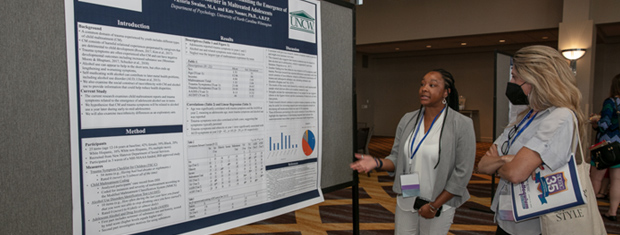




The APSAC Advisor is a peer reviewed quarterly news journal for professionals in the field of child abuse and neglect.
The APSAC Advisor provides succinct, data-based, practice-oriented articles that keep interdisciplinary professionals
informed of the latest developments in policy and practice the field of child maltreatment. It is designed to highlight
best practices in the field and publish original articles and current information about child maltreatment for professionals
from a variety of backgrounds including medicine, law, law enforcement, social work, child protective services, psychology,
public health and prevention in the U.S.
 If you wish to learn more about submitting an article to the Advisor, please click here.
If you wish to learn more about submitting an article to the Advisor, please click here.
This library contains Advisor issues dating back to the first issue in 1988. The most recent issue appears at the top.
Scroll down to select past issues by year and issue number. Once a publication appears in the box, you
can use the Enlarge button to open the document in a new window or tab (depending on how your browser is set up).
This will allow you to view the document with larger print.
To print a document, first use the Enlarge button to open the document in a new window or tab. Then use your browser's Print command.
To return here from a new tab, close the tab. To return from a new window, click your browser's Back button.
In the listing below, click on a year and issue number to see the articles in that publication.
2020 Number 2
This article is an introduction to a series of nine articles that provide an update on the most prominent forensic interviewing strategies. This article provides a brief introduction and history to contextualize current forensic interview practice. The article highlights both differences and similarities among forensic interview structures. It makes specific reference to the endeavor by the Office of Juvenile Justice and Delinquency Prevention in 2015 to bring together major organizations and individuals charged with forensic interview guidelines to produce a consensus statement (Newlin et al., 2015). Next, the article provides a brief introduction to the interview structures and articles in this issue. It concludes with advice to the readers and an admonition about the importance of thinking critically about forensic interviewing practices.
APSAC’s Approach to Child Forensic Interviews: Learning to Listen
This article describes APSAC’s work to bridge the gap between researchers and forensic interviewers and develop training and guidelines related to child forensic interviewing best practices. Reference to APSAC’s Code of Ethics underscores the ethical obligations of interviewers to act in a manner consistent with the best interests of children�"striving to elicit reliable information while taking into account the individual child’s cultural background and special needs. APSAC’s Child Forensic Interview Clinic, first offered in 1997, and APSAC’s national 2012 Practice Guidelines on Forensic Interviewing in Cases of Suspected Abuse emphasize the fundamental goal of learning to listen effectively to children through genuine engagement, successful use of open-ended prompts, and a recognition that best practices will continue to evolve based on new research and interviewer experiences.
A Look Inside the CornerHouse Forensic Interview Protocol™
Professionals have used the CornerHouse Forensic Interview Protocol™ to conduct forensic interviews since 1989 and have used it to train interviewers worldwide since 1990. The protocol currently in practice consists of four possible stages: Build Rapport, Seek Information, Explore Statements, and End Respectfully. It is built upon the Guiding Principles of being Person Centered, Semi-Structured, and Forensically Sound. In efforts to increase understanding of the protocol, this article offers a look inside the CornerHouse Forensic Interview Protocol™, providing an overview through description of each stage and of the Recommended Methods and Possible Tools incorporated into the protocol.
NICHD: Where We’ve Been and Where We Are Now
The purpose of this paper is to review the National Institute of Child Health and Human Development (NICHD) Protocol, with specific focus on its revisions and adaptations. The aim is to dispel myths surrounding the protocol and to provide a clearer understanding of its major objectives and advancements. Additionally, this paper discusses refinements to the protocol and the rationale for those refinements. Particular focus will be on the adaptations in Utah. The authors are child forensic interview experts and experienced trainers on the uses and adaptations of this forensic interviewing protocol.
Why RADAR? Why Now? An Overview of RADAR Child Interview Models
RADAR premiered in 2009 and has since earned a place on the national stage as a best practice child forensic interview model, especially geared toward new interviewers. Tis article describes the four objectives that served as the impetus for developing RADAR in an already crowded feld of interview protocols. Tese four objectives also defne RADAR’s unique niche in the feld of child forensic interviewing: 1) to operationalize and promote forensic balance in forensic interviews; 2) to make best practice forensic interview training more accessible; 3) to expedite the transformation of interviewers from new to good to expert; and 4) to advance the feld through innovations in interview design and instruction. RADAR comprises three child interview models for use in investigations of child maltreatment or sexual exploitation: RADAR Child Forensic Interview (for ages 5 through adolescence), RADAR JR Child Forensic Interview (for ages 3½ to 5½), and FirstCall Initial Investigative Interview (frst responder interview). Tis article brie?y describes each model. It also introduces a 6-step instructional method for expediting the training of novice interviewers.
The Evolution of The Childhood Trust Child Forensic Interview Training
The Childhood Trust's Child Forensic Interview Training Institute has evolved while continuing to honor its originators' work. The course has changed names and refined its objectives adhering to basic skill-building. By providing an interview framework from which learners can build, the training assists interviewers in adapting the framework to meet the needs of children while also considering the expectations of their jurisdictions. With both science and art being the guiding forces, the Child Forensic Interview Training teaches a child-focused, trauma-informed approach to maximizing information from children while minimizing negative impact on the child or the case.
ChildFirst® Forensic Interview Training Program
ChildFirst® is one of the most widely used forensic interview training programs and protocols in the United States, Japan, and Colombia. Multi-disciplinary teams (MDTs) are able to access the training at a national level and also at a local level in states authorized to teach the course. This article outlines the history of the program and summarizes the evolution and growth of ChildFirst®. It also outlines the four phases of the ChildFirst® protocol, the polyvictimization screen, and other prominent features of the model. ChildFirst® includes not only the basic five-day course but also a series of advanced courses as well as a national infrastructure to support MDTs utilizing the model.
Interviewing Preschool Children
Conducting forensics interviews of potential child victims/witnesses is an important and complex task, no matter the age of the children, and is an essential component of investigations of alleged abuse. However, forensic interviewers face unique challenges when questioning preschool children about possible experiences of maltreatment for a variety of cognitive and socioemotional reasons. It is well documented that preschool children can provide accurate information about remembered experiences when interviewers properly question them in a way that does not exceed the children’s developmental abilities. Preschool children, like older children, provide the most complete and accurate information when interviewers emphasize free-recall retrieval strategies. Experts must adapt recommendations for evidence-based practice in forensic interviewing to meet the emotional and developmental needs and respect the limitations of very young children serving as witnesses.
Taking AIM: Advanced Interview Mapping for Child Forensic Interviewers
Child forensic interview protocols universally agree that eliciting a detailed, free-narrative account of the child’s experiences, in the child’s own words, is best practice. Rather than adhering to best practice standards, however, many forensic interviewers revert within months of training to old habits like reliance on specific and closed questions. Advanced Interview Mapping (AIM) is a practical, easy-to-learn tool for use in peer and self-review to ensure interview quality and to prevent interviewer drift. AIM offers a methodology for assessing the type and sequencing of questions used in the Eliciting Account or Substantive phase of the interview for an objective appraisal of questioning strategies. With practice, interviewers can map most interviews from a video or audio recording, regardless of the forensic interview protocol employed.
Child forensic interviewing can be viewed as having two core objectives: the protection of child victims from abuse and the protection of innocent adults from false allegations. Forensic balance is defined as emphasizing both objectives equally in interview design, instruction, and practice. A review of the 40+ year history of child forensic interviewing suggests that our field has predominantly prioritized adult protection at the expense of child protection. This article is a call for revisions in interview guidelines to recognize forensic balance as a foundational best practice standard. It also proposes four interview standards of practice as an initial model to operationalize forensic balance.
APSAC Advisor 32(2): Full issue